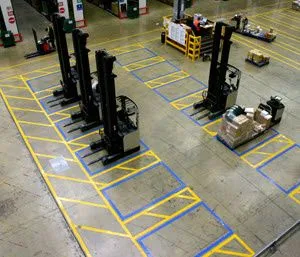Warehouse floors might seem like vast, empty expanses, but for those who work within them, they're a carefully choreographed ballet of movement. Forklifts zip and zoom, pallets dance across aisles, and workers navigate a complex ecosystem of inventory and activity. In this bustling world, a silent yet critical conductor ensures order and safety: warehouse line marking.
Safety First: A Clear Line Between Danger and Efficiency
Warehouse line marking isn't just about aesthetics; it's about creating a visual language that prioritizes safety. Brightly colored lines demarcate designated walkways for pedestrians, keeping them safely separated from the whirring blades of forklifts and the rumbling of heavy machinery.
Think of it as a high-visibility vest for the floor, instantly communicating danger zones and safe passageways. This reduces the risk of collisions, accidents, and injuries, making the warehouse a more secure and productive environment for everyone.
Boosting Efficiency: Painting a Path to Productivity
But line marking's magic goes beyond just safety. It's also a masterclass in efficiency. Designated traffic lanes for forklifts and other equipment to streamline movement, preventing bottlenecks and delays. Clearly marked pallet storage areas optimize space utilization, allowing for faster retrieval and restocking.
Imagine a warehouse floor without lines. It's like searching for a specific book in a library without the Dewey Decimal System. Line marking provides a visual map, guiding workers and equipment to their destinations quickly and accurately. This translates to improved order fulfillment times, reduced labor costs, and a happier, more productive workforce.
More Than Just Lines: A Colorful Canvas for Enhanced Operations
Warehouse line marking isn't a one-size-fits-all solution. Different colors and patterns can be used to designate specific functions, areas, or even hazard levels. For example, red lines might mark restricted zones, while blue lines could indicate loading docks. This color-coded system further enhances communication and clarity, empowering workers to make informed decisions and navigate the warehouse with confidence.
The Bottom Line: A Small Investment, A Big Return
Investing in proper warehouse line marking might seem like a minor detail, but its impact is undeniable. It's a cost-effective way to improve safety, boost efficiency, and optimize space utilization. It's a silent language that speaks volumes about a company's commitment to its employees, its operations, and its bottom line.
So, the next time you step into a warehouse, take a moment to appreciate the silent symphony of lines guiding the flow of activity. Remember, those stripes aren't just painted; they're the unsung heroes of a well-functioning warehouse, quietly orchestrating a ballet of safety and efficiency.
By prioritizing warehouse line marking, we can transform these bustling hubs into safer, smoother, and more productive spaces for everyone. Let's paint a path to a brighter future, one well-marked floor at a time.







